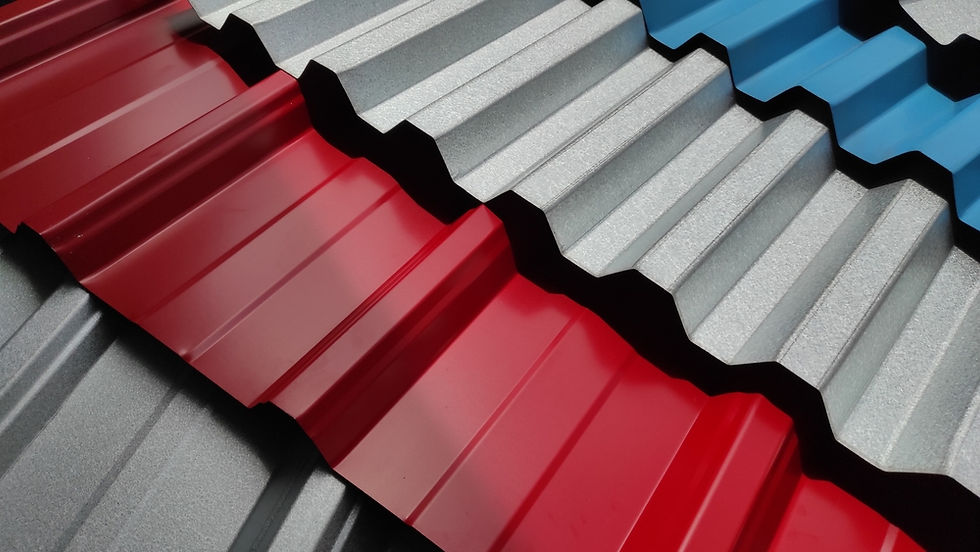The Ultimate Guide to Installing Colorbond Roof Sheets
- annawrench1315
- Aug 19
- 6 min read
Have you ever wondered why so many Australian homes have the smooth, modern metal roofs that Mother Nature have met everything that throws them? Do you consider a ceiling upgrade but feel overwhelmed by the installation process? What if you can replace your home with a roof solution that is not only durable, but also aesthetically comfortable?
Welcome to your all-in-one guide to install Colorbond Roof sheet. Whether you are a curious DIY enthusiast or just want to understand what goes into a professional installation, this guide breaks everything you should know. From choosing the right profile and colors to understanding installation techniques and maintenance requirements, we will drive you through each step of the journey.
Understanding Colorbond Roof Sheets
Types of Colorbond Profiles Available
Colorbond comes in different profiles, designed for each specific applications and aesthetic preferences. The most popular alternative is wave glands, which have the classic wave pattern, which is a major in Australian architecture for generations.
For those looking for more modern looks, the elegant standing seam profile is a profile, which creates clean lines and a sophisticated look. Custom ORB provides a soft, round corridor that works beautifully with curved roof.

Choosing the Right Thickness and Grade
Colorbond sheets come in different thicknesses, usually from 0.42 mm to 0.60 mm for housing applications. Standard 0.42 mm Basic metal thickness (BMT) fits most homes and provides an ideal balance between strength and cost efficiency. However, if you live in an area suffering from severe weather or shotgun, it can be considered to upgrade up to 0.48 mm.
For coastal properties, ultra in Marin class Colorbond is essential. This premium option increases the corrosion resistance to handle salt spray and tough coastal conditions.
Colorbond Colour Range and Selection Tips
With more than 20 standard colors and extra designer options, Colorbond provides incredible flexibility to achieve the desired aesthetics. Classic options such as memorials, Surfmist and Woodland Gray are popular for their versatility and timeless appeal.
When choosing a color, consider the existing properties of your house, including brick colors, window frame and surrounding landscape. Many homeowners help order swatches and look at them at different times of day, as light can affect the look dramatically.
Pre-Installation Planning
How Much Do Colorbond Roof Sheets Cost?
The cost of Colorbond roof sheets varies depending on several factors, including profile type, colors and current market conditions. As a thick guide, alone, the sheets are expected to pay between $ 10 to $ 20 per square meter. Premium colors and have options are at the high end of this area.
However, ARK represents only one component of the total project cost. Factor in additional materials such as fasteners, flashing, back cover and insulation. These extra usually add 20-30% to the cost of your content.
Calculating Materials: How Many Sheets Do I Need?
Accurate content prevents calculation of expensive delays and reduces waste. Start by measuring your roof area where all classes need to be covered. For simple rectangular ceilings, multiply the length with the width for each section. More complex roofs require the region to break into manageable forms.
Create a detailed list, including the maternity shipping, valleys, barber suits and special flashing required around the chimney or skylights. It is intelligent to order 5-10% additional material to cover errors, damage or future repair.
Essential Tools and Equipment Checklist
The right equipment makes the installation safe and more efficient. In the necessary electrical appliances, a spherical set of metal -cut knives or tin snips to cut the sheet, and a quality exercise with hexagonal drivers for fasteners.
Safety equipment is non-parasitic. You need good grip, safety glasses, work gloves and strong work shoes with a hard hat.
Council Permits and Building Regulations
Most roof replacement requires approval of the Council, although the requirements vary between local authorities. Building permits ensure that your project meets safety standards and local planning rules. Failure to get a proper permit can lead to punishment and complications when selling your property.
Professional installers typically handle the permission application as part of the service, but the DIY installation program must independently navigate the process.
Step-by-Step Installation Guide
Preparing the Roof Structure
Before any Colorbond sheets go up, the underlying structure requires a thorough inspection and preparation. Check all the rafters and baton for damage, rot or inadequate vacancy. Colorbond -installation requires specific vacant vacancy based on the selected profile and local air assessment.
Installing roof sarking provides an extra weather barrier and improves thermal performance. This breathable membrane goes directly over rafters before battens, following manufacturer's overlap requirements.
Installing Colorbond Sheets
Proper sheet installation starts at the correct edge, typically the side opposite prevailing weather. This ensures overlaps face away from driving rain. Align your first sheet carefully using string lines, as this sets the pattern for the entire roof.
Safe sheets using the right fasteners in the right places. The screws go to the baton or purlin through the drain, at any time in the valleys where the water flows.
Cutting and Fitting
Cutting Colorbond sheets requires the right technique to avoid damaging protective coating. Use tin snips for small cuts or a circular saw with metal chopping knives for straight cuts. Always cut the sheets to reduce coating damage to the visual surface. Clean away metal filings immediately, as they cause rust stains.
Ridge capping installation forms the critical final weatherproofing layer. These specially formed pieces cover the roof peak, overlapping sheets from both sides.

How Long Do Colorbond Roofs Last?
Expected Lifespan and Warranty Information
Colorbond roofs usually provide extraordinary life when installed and maintained properly. Under normal conditions, you can expect a reliable service of 30-50 years, with many companies that also last longer. This lifetime exceeds traditional roofing materials during the need for little maintenance.
The actual world performance is often more than the guarantee period. Many Colorbond roofs established in the 1970s are functional today will for the durability of the material. However, achieving maximum life requires proper installation, regular maintenance and attention to any problem.
Factors Affecting Longevity
The state of the environment affects the lifetime of the roof. Coastal properties face challenges with salt spray, which require sea quality material and more frequent maintenance. Accelerated decline in coating can be experienced in industrial areas with air pollution. Rural properties usually have the longest life span due to cleaner air.
Roof design influences durability through water management and stress distribution. Simple designs with good drainage usually come out of complex configuration with multiple penetration. Regular maintenance, which involves cleaning gutter and early repair of damage, maximizes the service life regardless of design.
Maintenance Tips for Maximum Durability
Regular inspection forms the basis for good maintenance. Check your roof, in search of loose fasteners, in search of damaged sealing or accumulated debris. Pay special attention after severe weather events.
Cleaning requirements are minimal but important. Rinse the ceiling annually with clean water to remove dirt, pollution and organic materials.
Troubleshooting Common Issues
Dealing with Leaks and Water Damage
Leak detection requires systematic investigation. Start by identifying where water appears inside, then trace back to the source. Remember water can travel significant distances along framing before appearing as damage. Common leak sources include damaged fastener seals, poor flashing installation, or blocked gutters.
Professional assistance often proves most economical for leak repairs. They possess specialised detection equipment and understand water movement patterns. DIY attempts sometimes worsen problems by creating additional penetrations or using inappropriate materials.
Fixing Loose or Damaged Sheets
Sheet damage from falling branches or severe weather requires prompt attention. Small dents rarely affect performance but can repair for aesthetic reasons. Compensation for tears, large folds or penetration damage is necessary to compromise waterproofing.
Loose sheets pose immediate danger and require urgent securing. Never attempt repairs during windy conditions. Temporary securing prevents further damage until proper repairs commence. Investigate why sheets loosened to prevent recurrence.
Cost-Saving Tips and Considerations
Best Times to Buy Colorbond Materials
Steel market prices up with market status and seasonal demand. Late autumn through the winter usually results in better prices as a decline in demand. Suppliers can offer special or obvious old stock colors at the end of the year-old year.
The plan generates significant savings during the supplier campaign. Sign up for the newspaper from large suppliers to get sales information. Balance savings against storage costs and potential damage if the material is longer than the installation.
Energy Efficiency and Long-term Savings
Colour choices greatly affect energy costs. Light colors reflect more heat and reduce the requirements for summer cooling. In cooler climate absorbs dark colors heat from favorable winter. Consider your climate and primary energy usage when selecting colours.
Rainwater harvesting from Colorbond roofs provides excellent quality water for gardens and toilets. The clean surface doesn't contaminate water like some materials. Installing tanks during roofing works reduces future connection costs.
Conclusion
Installing Colorbond roof sheets represents an important investment in the future of your property. During this guide we have discovered all aspects from the first plan for maintenance. The most important technological uve is that success lies in honor of complete preparation, focus on expansion and security requirements.
The new Colorbond roof will only act as more than weather protection. This is an aesthetic growth that reflects Australian innovation and quality. To follow the guidelines mentioned here and maintain your roof properly, you are sure it looks good and performs innocent for generations to come. Here for many years are safe, stylish shelters under the new Colorbond roof!








Comments